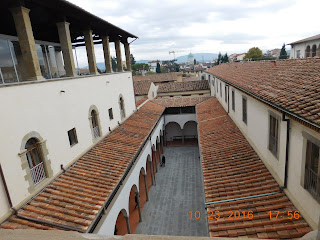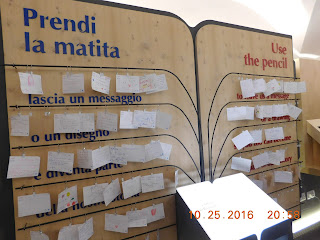Ospedale degli Innocenti: the hospital
of the innocents
Walking through
the Piazza Santissima Annunziata as an exchange student many years
ago, the imposing building on the east side of the piazza was never
open, but it has proudly kept its long history of service to
children.
For the past year+
scaffolding and plastic sheathing has promised a renovation that will educate
visitors on the buildings’ history.
The building style
was unique for the 1400 and well documented in Wikipedia.
Now open to the
public the ospedale innocente tells the story of the children left at the
infants table (a circular platform that rotated to send the infant to the
interior of the building) or older children brought to the ospedale when
parents could no longer care for them. Parents
entrusted children to the ospedale until the family might be able to
continue to care for them.
 |
This window was where infants were left for the sisters to take in.
The infant had to fit within the grill work to be left here.
|
Three floors are
open to view for a small admission fee.
On the top floor is a large glassed wall café with outside seating to
enjoy the rooftop views. Off the
cloister on the prima piano is a large meeting room and many other doors that
were not open to visitors.
This is an
interactive museum with audio, videos and text available in English as well as
Italian. A headset is an additional
fee. You can spend as much time as you
wish at each exhibit.
Each
drawer was labeled with a child’s name and a date. Inside is the original item a mother might
have left with her child so that identification might be easier when a parent
returned to claim their offspring.
Opening a drawer from more than 200 or 300 years ago, you find a ribbon
or half of a medal (the parent would keep the other half) and other mementos
that came to the ospedale with a child.
I inspected dozens of boxes, some from the late 1800’s thinking of the mothers who left their children to be
cared at the institute.
There is a note
station nearby where you are asked to leave a message. Videos of several of
former siblings of children adopted from the ospedale can also be played in
English and explained how a family might bring a child from the ospedale home
to join their other children.
Black and white
photo show some of the children and workers, always formal photos.
You could easily
spend most of the day reading all the display entries, enjoying lunch in the
café and viewing the extensive art exhibit also housed in the buildings. I saw Italian tour guides with small
groups in the museum but no mention of any scheduled tours.
The top floor art
gallery houses pieces from very well-known artists. The room is striking from an architectural
view point.
A large gift shop is located on the first floor, free lockers at the entrances allow you to store handbags and back packs (free when I visited) and restrooms.
A large gift shop is located on the first floor, free lockers at the entrances allow you to store handbags and back packs (free when I visited) and restrooms.
There is a small
Church within the ospedale but it is only open on Sundays for mass. Perhaps on my next visit more of the interior
is renovated that exhibits from the daily lives of the children and the
caretakers will be on display: furniture, clothing, housewares and written
accounts from the years the ospedale was open.
Let your mind wander back hundreds of years and you are in Renaissance
Florence.













